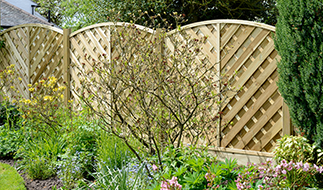- Gates
- Railings
- Fencing
- Accessories
& Fitting- Sheds
& Storage- Garden Structures
- Design
& StyleMetal Gates & Railings- Info
& Help2020-10-01
Wooden fence panels may not be the most exciting addition to a garden, but fencing is crucial to ensuring privacy, safety and security. Many homeowners in the UK take pride in their gardens, and fences are crucial to create an outdoor haven that’s warm, welcoming and characterful.
That said, there are different kinds of materials used to create garden fencing, and the majority of people opt for wood. Wood panels have proven to be reliable, strong and easy to maintain, but there's one concern that we may be able to put to bed.
“How long does it last?”
The type of wood used and the quality of the installation is always going to be paramount to life expectancy, however, most timber fences will serve you well for the best part of 15 years — if they have been well-maintained.
Although the list of wood species is huge, the three primary types are cedar, pine and spruce. Pine is relatively inexpensive and easy to work with, yet it also resists shrinkage. You do not, however, get the level of durability that cedar affords. Cedar contains natural insect-repelling substances, but as a result it can be more expensive than other species. Spruce is another budget-friendly option and it accepts stain very well, however, it can warp and also tends to be less durable than cedar.
Though these materials each have their own advantages and disadvantages that you can read into further online, the main takeaway is to choose timber fencing that has been pressure treated, because you can then have total peace of mind that it will last many years — no matter the type you choose.
Spare a thought for your local climate
Another preliminary to take into account is the climate within your region. Unfortunately, wood has the potential to suffer from rot and decay when it is too humid. It is because wood absorbs water over time and apart from decaying, the fence will crack and potentially become inefficient. With the right maintenance in place you can prevent your fences from wasting away, increasing life expectancy. This is crucial for those situated in windy and wet locations. As an example, seafront homes can suffer serious water damage throughout the year, so by frequently painting or staining, you can upgrade the condition of the wood, thus increasing its durability.
You have the option to choose rot-resistant wood if the weather is unfavourable. Frequent cleaning is a must too. Try to remove dirt and debris to improve the condition of your fencing. Last but not least, the mode of installation also influences longevity. The best approach is to work with a professional.
We do hope this information was of use to you, but should you have any questions or wish to learn more about our timber fencing products, please get in touch with our friendly team on 0844 804 5577.
- Railings
sales@gardengatesdirect.co.uk



